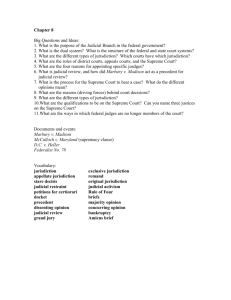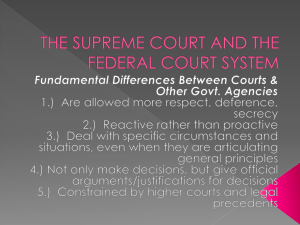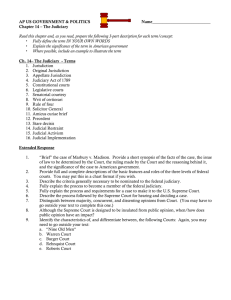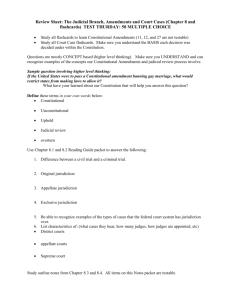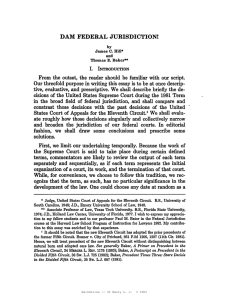The Judicial Branch
advertisement
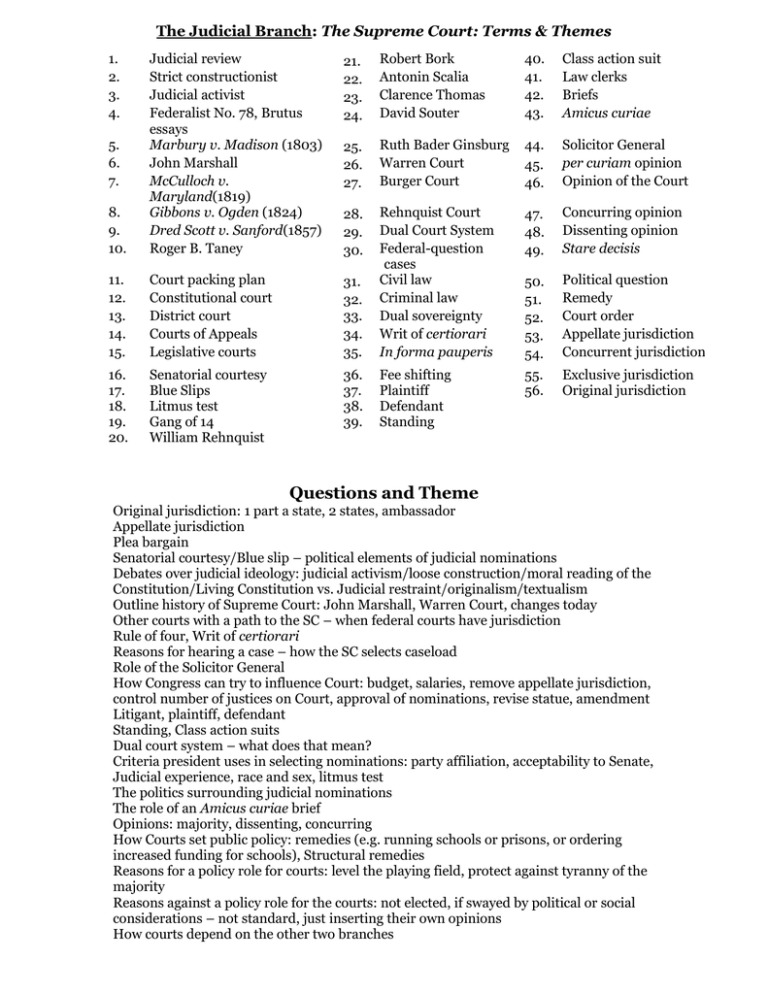
The Judicial Branch: The Supreme Court: Terms & Themes 1. 2. 3. 4. 21. 22. 23. 24. Robert Bork Antonin Scalia Clarence Thomas David Souter 40. 41. 42. 43. Class action suit Law clerks Briefs Amicus curiae 25. 26. 27. Ruth Bader Ginsburg Warren Court Burger Court 44. 45. 46. Solicitor General per curiam opinion Opinion of the Court 8. 9. 10. Judicial review Strict constructionist Judicial activist Federalist No. 78, Brutus essays Marbury v. Madison (1803) John Marshall McCulloch v. Maryland(1819) Gibbons v. Ogden (1824) Dred Scott v. Sanford(1857) Roger B. Taney 28. 29. 30. 47. 48. 49. Concurring opinion Dissenting opinion Stare decisis 11. 12. 13. 14. 15. Court packing plan Constitutional court District court Courts of Appeals Legislative courts 31. 32. 33. 34. 35. Rehnquist Court Dual Court System Federal-question cases Civil law Criminal law Dual sovereignty Writ of certiorari In forma pauperis Political question Remedy Court order Appellate jurisdiction Concurrent jurisdiction 16. 17. 18. 19. 20. Senatorial courtesy Blue Slips Litmus test Gang of 14 William Rehnquist 36. 37. 38. 39. Fee shifting Plaintiff Defendant Standing 50. 51. 52. 53. 54. 55. 56. 5. 6. 7. Exclusive jurisdiction Original jurisdiction Questions and Theme Original jurisdiction: 1 part a state, 2 states, ambassador Appellate jurisdiction Plea bargain Senatorial courtesy/Blue slip – political elements of judicial nominations Debates over judicial ideology: judicial activism/loose construction/moral reading of the Constitution/Living Constitution vs. Judicial restraint/originalism/textualism Outline history of Supreme Court: John Marshall, Warren Court, changes today Other courts with a path to the SC – when federal courts have jurisdiction Rule of four, Writ of certiorari Reasons for hearing a case – how the SC selects caseload Role of the Solicitor General How Congress can try to influence Court: budget, salaries, remove appellate jurisdiction, control number of justices on Court, approval of nominations, revise statue, amendment Litigant, plaintiff, defendant Standing, Class action suits Dual court system – what does that mean? Criteria president uses in selecting nominations: party affiliation, acceptability to Senate, Judicial experience, race and sex, litmus test The politics surrounding judicial nominations The role of an Amicus curiae brief Opinions: majority, dissenting, concurring How Courts set public policy: remedies (e.g. running schools or prisons, or ordering increased funding for schools), Structural remedies Reasons for a policy role for courts: level the playing field, protect against tyranny of the majority Reasons against a policy role for the courts: not elected, if swayed by political or social considerations – not standard, just inserting their own opinions How courts depend on the other two branches



